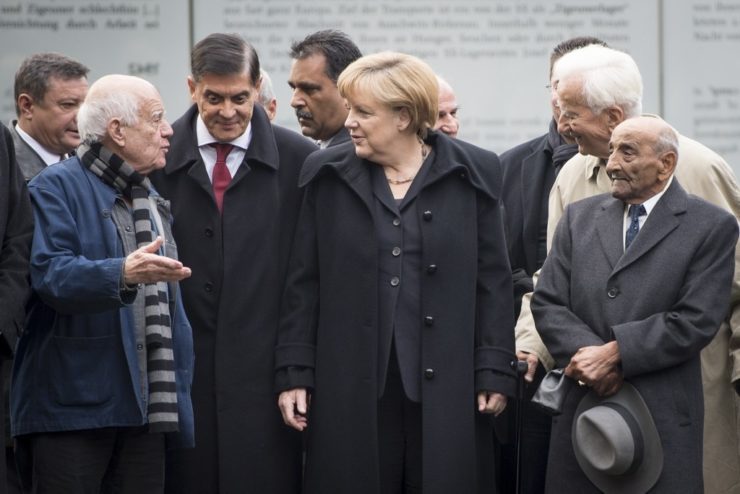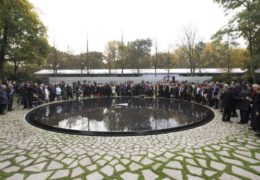“The protection and preservation of the monument to the Sinti and Roma of Europe murdered under National Socialism is our top priority. Here we have brought together our ties from our common history, our common fate of Jews, Sinti and Roma, as artists on the one hand and as civil rights activists and politicians on the other”, Dani Karavan and Romani Rose declared together after an extensive conversation.

For Dani Karavan and for the Central Council of German Sinti and Roma the monument is of the highest moral and political significance. For Sinti and Roma in Germany and in Europe, the memorial is a central place of remembrance and at the same time a place of remembrance of the crimes of the Holocaust, to which more than 500,000 Sinti and Roma fell victim.
“Therefore, it was and is incomprehensible to us that neither the artist nor the Central Council of German Sinti and Roma were informed about this project of the S21 at an early stage and that our position was asked for. We only learned of the plans in March of this year, even though there had been talks between Deutsche Bahn and the Foundation ‘Memorial to the Murdered Jews of Europe’ since at least 2017,” Rose said in an interview with Dani Karavan.
Due to the current discussion, politics and Deutsche Bahn are now called upon and obliged to either present a new acceptable alternative – or to clearly clarify the requirements for the variant 12f presented by Deutsche Bahn in previous talks. Dani Karavan and Romani Rose jointly declare: “The place where the monument with the Black Water Basin in the centre is located must not be called into question, it must be protected in the sense of commemoration, the dignity of the place and in the sense of historical responsibility“.
Dani Karavan now expects the Berlin Senate to make a clear statement about the course of the S21 route: “Protection and preservation of the monument is the top priority, we must know exactly what is planned here. The monument is not just the Black Basin, it is the entire site. Only when we see what is being planned in concrete terms can we say how we will deal with the requirements. Any intervention in the monument must be coordinated with the Central Council of German Sinti and Roma and with me as the responsible artist.”
Romani Rose also calls on politicians and the railways: “There must now be clarity in a discussion that is increasingly playing into the hands of nationalists and the right. It is intolerable that this symbolic place should be turned into a plaything in the social media.“
The Central Council has stated on several occasions that it will not give its approval to a decision by the responsible institutions that does not take due account of the interests of the minority and the place of remembrance of the victims. At the same time, the Central Council of German Sinti and Roma is aware that the expansion of the Berlin S-Bahn network is of great importance for the city.
Background information:
In the past, two important political decisions were made for the construction of the S21 – in each case without taking the monument sufficiently into account:
Firstly, the Berlin Senate has decided to build the S21 in order to fully integrate Berlin’s central station into the S-Bahn network via a north-south link. This decision is of great importance for Berlin’s public transport system.
Secondly, the German Bundestag decided that the historic Reichstag building must not be affected; the work of Parliament must not be hindered, and the safety of the building and Parliament must not be endangered.
“Deutsche Bahn had played through various options on the basis of these requirements. The last variant 13 would not have affected the monument, but was unanimously rejected by the Council of Elders of the German Bundestag. And now we’re back to option 12, which involves erecting a four-metre-high protective wall close to the Black Basin, which separates the monument from the Bundestag, because the construction site begins behind it. A commemoration at this place would then be impossible. The noise of the trucks, the construction site, the wooden wall – this is not an acceptable solution for us,” says Rose.
The Central Council of German Sinti and Roma was not officially informed of the planned route for the S21 until March 2020. Prior to this, there had been no contact whatsoever on the part of Deutsche Bahn or the Berlin Senate, neither with the Central Council nor with Dani Karavan, the artist responsible for the monument. It was only after a meeting between the Stiftung Denkmal and representatives of Deutsche Bahn on 10 March 2020 that the Central Council learned of the plans for the S21. However, talks between Deutsche Bahn and the Foundation “Memorial to the Murdered Jews of Europe” have been going on since 2017/18.
Since June 2020, at the invitation of Senator Günther and the Deutsche Bahn, there have been talks in which the Central Council of German Sinti and Roma and all the institutions involved are taking part. The Central Council expects that these talks will be continued in order to reach an appropriate solution.


